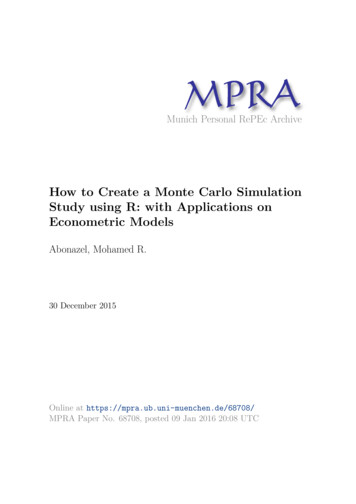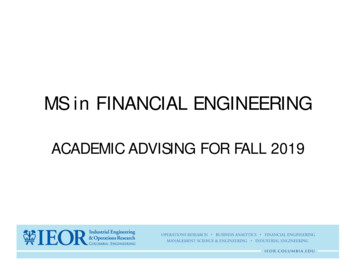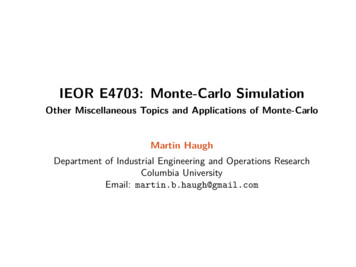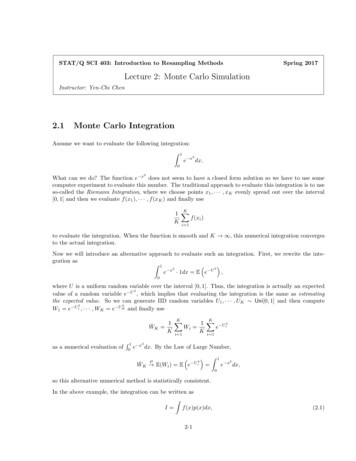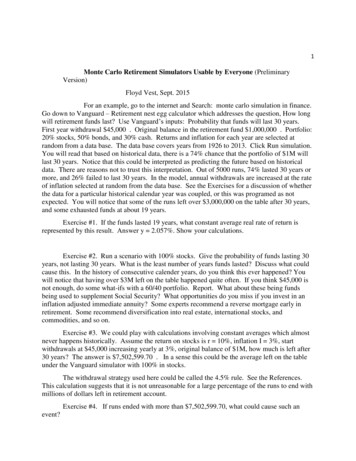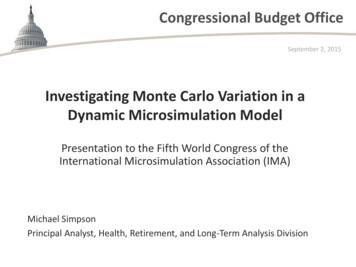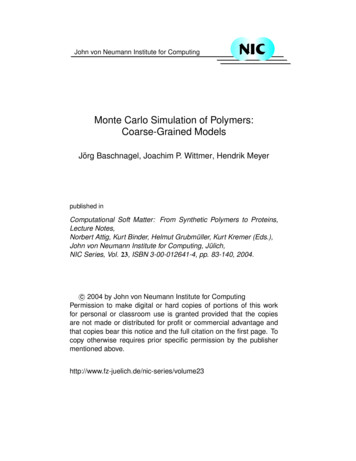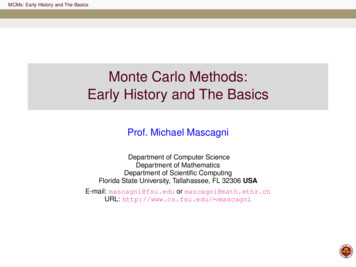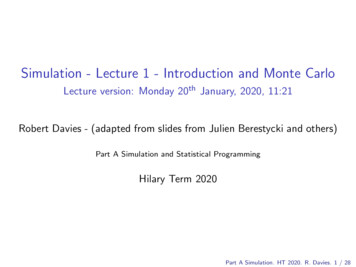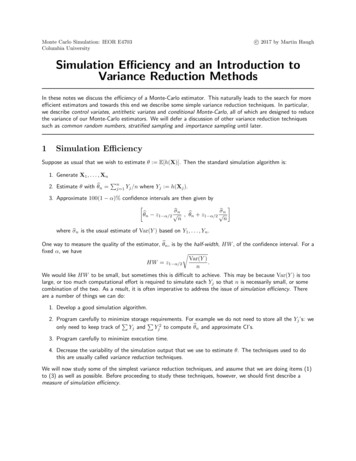
Transcription
Monte Carlo Simulation: IEOR E4703Columbia Universityc 2017 by Martin HaughSimulation Efficiency and an Introduction toVariance Reduction MethodsIn these notes we discuss the efficiency of a Monte-Carlo estimator. This naturally leads to the search for moreefficient estimators and towards this end we describe some simple variance reduction techniques. In particular,we describe control variates, antithetic variates and conditional Monte-Carlo, all of which are designed to reducethe variance of our Monte-Carlo estimators. We will defer a discussion of other variance reduction techniquessuch as common random numbers, stratified sampling and importance sampling until later.1Simulation EfficiencySuppose as usual that we wish to estimate θ : E[h(X)]. Then the standard simulation algorithm is:1. Generate X1 , . . . , XnPn2. Estimate θ with θbn j 1 Yj /n where Yj : h(Xj ).3. Approximate 100(1 α)% confidence intervals are then given by σbnσbnθbn z1 α/2 , θbn z1 α/2 nnwhere σbn is the usual estimate of Var(Y ) based on Y1 , . . . , Yn .One way to measure the quality of the estimator, θbn , is by the half-width, HW , of the confidence interval. For afixed α, we haverVar(Y )HW z1 α/2.nWe would like HW to be small, but sometimes this is difficult to achieve. This may be because Var(Y ) is toolarge, or too much computational effort is required to simulate each Yj so that n is necessarily small, or somecombination of the two. As a result, it is often imperative to address the issue of simulation efficiency. Thereare a number of things we can do:1. Develop a good simulation algorithm.2. Program carefully to minimize storage requirements. For example we do not need to store all the Yj ’s: wePP 2only need to keep track ofYj andYj to compute θbn and approximate CI’s.3. Program carefully to minimize execution time.4. Decrease the variability of the simulation output that we use to estimate θ. The techniques used to dothis are usually called variance reduction techniques.We will now study some of the simplest variance reduction techniques, and assume that we are doing items (1)to (3) as well as possible. Before proceeding to study these techniques, however, we should first describe ameasure of simulation efficiency.
Simulation Efficiency and an Introduction to Variance Reduction Methods1.12Measuring Simulation EfficiencySuppose there are two random variables, W and Y , such that E[W ] E[Y ] θ. Then we could choose toeither simulate W1 , . . . , Wn or Y1 , . . . , Yn in order to estimate θ. Let Mw denote the method of estimating θ bysimulating the Wi ’s. My is similarly defined. Which method is more efficient, Mw or My ? To answer this, letnw and ny be the number of samples of W and Y , respectively, that are needed to achieve a half-width, HW .Then we know that 2 z1 α/2Var(W )nw HW z 21 α/2ny Var(Y ).HWLet Ew and Ey denote the amount of computational effort required to produce one sample of W and Y ,respectively. Then the total effort expended by Mw and My , respectively, to achieve a half width HW are z 21 α/2T Ew Var(W ) EwHW z 21 α/2T Ey Var(Y ) Ey .HWWe then say that Mw is more efficient than My if T Ew T Ey . Note that T Ew T Ey if and only ifVar(W )Ew Var(Y )Ey .(1)We will use the quantity Var(W )Ew as a measure of the efficiency of the simulator, Mw . Note that (1) implieswe cannot conclude that one simulation algorithm, Mw , is better than another, My , simply becauseVar(W ) Var(Y ); we also need to take Ew and Ey into consideration. However, it is often the case that wehave two simulators available to us, Mw and My , where Ew Ey and Var(W ) Var(Y ). In such cases it isclear that using Mw provides a substantial improvement over using My .2Control VariatesSuppose you wish to determine the mean midday temperature, θ, in Grassland and that your data consists of{(Ti , Ri ) : i 1, . . . n}where Ti and Ri are the midday temperature and daily rainfall, respectively, on some random day, Di . Thenθ E[T ] is the mean midday temperature.If the Di ’s are drawn uniformly from {1, . . . , 365}, then an obviousestimator for θ isPnTiθbn i 1nand we then know that E[θbn ] θ. Suppose, however, that we also know:1. E[R], the mean daily rainfall in Grassland2. Ri and Ti are dependent; in particular, it tends to rain more in the cold seasonIs there any way we can exploit this information to obtain a better estimate of θ? The answer of course, is yes.PnLet Rn : i 1 Ri /n and now suppose Rn E[R]. Then this implies that the Di ’s over-represent the rainyseason in comparison to the dry season. But since the rainy season tends to coincide with the cold season, italso means that the Di ’s over-represent the cold season in comparison to the warm season. As a result, weexpect θbn θ. Therefore, to improve our estimate, we should increase θbn . Similarly, if Rn E[R], we shoulddecrease θbn .In this example, rainfall is the control variate since it enables us to better control our estimate of θ. Theprinciple idea behind many variance reduction techniques (including control variates) is to “use what you know”
Simulation Efficiency and an Introduction to Variance Reduction Methods3about the system. In this example, the system is Grassland’s climate, and what we know is E[R], the averagedaily rainfall. We will now study control variates more formally, and in particular, we will determine by howmuch we should increase or decrease θbn .2.1The Control Variate MethodSuppose again that we wish to estimate θ : E[Y ] where Y h(X) is the output of a simulation experiment.Suppose that Z is also an output of the simulation or that we can easily output it if we wish. Finally, we assumethat we know E[Z]. Then we can construct many unbiased estimators of θ:1. θb Y , our usual estimator2. θbc : Y c(Z E[Z])for any c R. The variance of θbc satisfiesVar(θbc ) Var(Y ) c2 Var(Z) 2c Cov(Y, Z).(2)and we can choose c to minimize this quantity. Simple calculus then implies the optimal value of c is given byc Cov(Y, Z)Var(Z)and that the minimized variance satisfiesVar(θbc ) Cov(Y, Z)2Var(Z)2b Cov(Y, Z) .Var(θ)Var(Z)Var(Y ) In order to achieve a variance reduction it is therefore only necessary that Cov(Y, Z) 6 0. The new resultingMonte Carlo algorithm proceeds by generating n samples of Y and Z and then settingPn(Yi c (Zi E[Z])).θbc i 1nThere is a problem with this, however, as we usually do not know Cov(Y, Z). We overcome this problem bydoing p pilot simulations and settingPpj 1 (Yj Y p )(Zj E[Z])dCov(Y,Z) .p 1If it is also the case that Var(Z) is unknown, then we also estimate it withPp2j 1 (Zj E[Z])dVar(Z) p 1and finally setbc dCov(Y,Z).dVar(Z)Assuming we can find a control variate, our control variate simulation algorithm is as follows. Note that the Vi ’sare IID, so we can compute approximate confidence intervals as before.
Simulation Efficiency and an Introduction to Variance Reduction Methods4Control Variate Simulation Algorithm for Estimating E[Y ]/ Do pilot simulation first /for i 1 to pgenerate (Yi , Zi )end forcompute bc / Now do main simulation /for i 1 to ngenerate (Yi , Zi )set Vi Yi bc (Zi E[Z])end forPnset θbbc V n i 1 Vi /nP2set σbn,v (Vi θbbc )2 /(n 1)hiσbbbc z1 α/2 σb n,vset 100(1 α) % CI θbbc z1 α/2 n,v,θnnExample 12Suppose we wish to estimate θ E[e(U W ) ] where U, W U (0, 1) and IID. In our notation we then have2Y : e(U W ) . The usual approach is:1. Generate U1 , . . . , Un and W1 , . . . , Wn , all IID U (0, 1)222. Compute Y1 e(U1 W1 ) , . . . , Yn e(Un Wn )Pn3. Construct the estimator θbn,y j 1 Yj /n 2is the usual estimate of Var(Y ).4. Build confidence intervals θbn,y z1 α/2 σbn,y / n where σbn,yNow consider using the control variate technique. First we have to choose an appropriate control variate, Z.There are many possibilities includingZ1: U WZ2: Z3: eU W(U W )2Note that we can easily compute E[Zi ] for i 1, 2, 3 and that it’s also clear that Cov(Y, Zi ) 6 0. In a simpleexperiment we used Z3 , estimating bc on the basis of a pilot simulation with 100 samples. We reduced thevariance by approximately a factor of 4. In general, a good rule of thumb is that we should not be satisfied unlesswe have a variance reduction on the order of a factor of 5 to 10, though often we will achieve much more.Example 2 (Pricing an Asian Call Option)Recall that the payoff of an Asian call option is given by Pm i 1 SiT /mh(X) : max 0, Kmwhere X : {SiT /m : i 1, . . . , m}, K is the strike price and T is the expiration date. The price of the optionis then given by rTCa EQh(X)]0 [e
Simulation Efficiency and an Introduction to Variance Reduction Methods5where r is the risk-free interest rate and Q is the risk-neutral probability measure. We will assume as usual thatSt GBM (r, σ) under Q. The usual simulation method for estimating Ca is to generate n independentsamples of the payoff, Yi : e rT h(Xi ), for i 1, . . . , n, and to setPnba i 1 Yi .CnBut we could also estimate Ca using control variates and there are many possible choices that we could use:1. Z1 ST2. Z2 e rt max(0, ST K)Pm3. Z3 j 1 SiT /m /mIn each of the three cases, it is easy to compute E[Z]. Indeed, E[Z2 ] is the well-studied Black-Scholes optionprice. We would also expect Z1 , Z2 and Z3 to have a positive covariance with Y , so that each one would be asuitable candidate for use as a control variate. Which one would lead to the greatest variance reduction?Exercise 1 Referring to Example 2, explain why you could also use the value of the option with payoff !1/mmYg(X) : max 0,SiT /m K i 1as a control variate. Do you think it would result in a substantial variance reduction?Example 3 (The Barbershop)Many application of variance reduction techniques can be found in the study of queuing, communications orinventory systems. As a simple example of a queuing system, consider the case of a barbershop where the barberopens for business every day at 9am and closes at 6pm. He is the only barber in the shop and he’s consideringhiring another barber to share the workload. First, however, he would like to estimate the mean total time thatcustomers spend waiting each day.Assume customers arrive at the barbershop according to a non-homogeneous Poisson process, N (t), withintensity λ(t), and let Wi denote the waiting time of the ith customer. Then, noting that the barber closes theshop after T 9 hours (but still serves any customers who have arrived before then) the quantity that he wantsto estimate is θ : E[Y ] whereN (T )XY : Wj .j 1Assume also that the service times of customers are IID with CDF, F (.), and that they are also independent ofthe arrival process, N (t). The usual simulation method for estimating θ would be to simulate n days ofoperation in the barbershop, thereby obtaining n samples, Y1 , . . . , Yn , and then settingPnj 1 Yjbθn .nHowever, a better estimate could be obtained by using a control variate. In particular, let Z denote the totaltime customers on a given day spend in service so thatN (T )Z : XSjj 1where Sj is the service time of the j th customer. Then, since services times are IID and independent of thearrival process, it is easy to see thatE[Z] E[S]E[N (T )]which should be easily computable. Intuition suggests that Z should be positively correlated with Y andtherefore it would also be a good candidate to use as a control variate.
Simulation Efficiency and an Introduction to Variance Reduction Methods2.26Multiple Control VariatesUntil now we have only considered the possibility of using one control variate but there is no reason why weshould not use more than one. Towards this end, suppose again that we wish to estimate θ : E[Y ] where Y isthe output of a simulation experiment. We also suppose that for i 1, . . . , m, Zi is an output or that we caneasily output it if we wish, and that E[Zi ] is known for each i. We can then construct unbiased estimators of θby definingθbc: Y c1 (Z1 E[Z1 ]) . . . cm (Zm E[Zm ])where ci R. The variance of θbc satisfiesVar(θbc ) Var(Y ) 2mXci Cov(Y, Zi ) i 1m XmXci cj Cov(Zi , Zj )(3)i 1 i 1and we could easily minimize this quantity w.r.t the ci ’s. As before, however, the optimal solutions c i willinvolve unknown covariances (and possibly variances of the Zi ’s) that will need to be estimated using a pilotsimulation.A convenient way of doing this is to observe that bc i bi where the bi ’s are the (least squares) solution to thefollowing linear regression:Y a b1 Z 1 . . . bm Z m (4)where is an error term. Note that you must include the intercept, a, in (4). The simulation algorithm withmultiple control variates is exactly analogous to the simulation algorithm with just a single control variate.Multiple Control Variate Simulation Algorithm for Estimating E[Y ]/ Do pilot simulation first /for i 1 to pgenerate (Yi , Z1,i , . . . , Zm,i )end forcompute bc j , j 1, . . . , m/ Now do main simulation /for i 1 to ngenerate (Yi ,PZ1,i , . . . , Zm,i )mset Vi Yi j 1 bc j (Zj,i E[Zj ])end forPnset θbc V n i 1 Vi /nP2set σbn,v (Vi θbc )2 /(n 1)ihσbbc z1 α/2 σb n,vset 100(1 α) % CI θbc z1 α/2 n,v,θnn
Simulation Efficiency and an Introduction to Variance Reduction Methods37Antithetic VariatesAs usual we would like to estimate θ E[h(X)] E[Y ], and suppose we have generated two samples, Y1 andY2 . Then an unbiased estimate of θ is given by θb (Y1 Y2 )/2 withb Var(θ)Var(Y1 ) Var(Y2 ) 2Cov(Y1 , Y2 ).4b Var(Y )/2. However, we could reduce Var(θ)b if we could arrange it so thatIf Y1 and Y2 are IID, then Var(θ)Cov(Y1 , Y2 ) 0. We now describe the method of antithetic variates for doing this. We will begin with the casewhere Y is a function of IID U (0, 1) random variables so that θ E[h(U)] where U (U1 , . . . , Um ) and theUi ’s are IID U (0, 1). The usual Monte Carlo algorithm, assuming we use 2n samples, is shown below.Usual Simulation Algorithm for Estimating θfor i 1 to 2ngenerate Uiset Yi h(Ui )end forP2nset θb2n Y 2n i 1 Yi /2nP2n2set σb2n i 1 (Yi Y 2n )2 /(2n 1)σb2nset approx. 100(1 α) % CI θb2n z1 α/2 2nIn the above algorithm, however, we could also have used the 1 Ui ’s to generate sample Y values, since ifUi U (0, 1), then so too is 1 Ui . We can use this fact to construct another estimator of θ as follows. As(i)(i)before, we set Yi h(Ui ), where Ui (U1 , . . . , Um ). We now also set Ỹi h(1 Ui ), where we use(i)(i)1 Ui to denote (1 U1 , . . . , 1 Um ). Note that E[Yi ] E[Ỹi ] θ so that in particular, ifZi : Yi Ỹi,2then E[Zi ] θ so that Zi is an also unbiased estimator of θ. If the Ui ’s are IID, then so too are the Zi ’s and wecan use them as usual to compute approximate confidence intervals for θ. We say that Ui and 1 Ui areantithetic variates and we then have the following antithetic variate simulation algorithm.Antithetic Variate Simulation Algorithm for Estimating θfor i 1 to ngenerate Uiset Yi h(Ui ) and Ỹi h(1 Ui )set Zi (Yi Ỹi )/2end forPnset θbn,a Z n i 1 Zi /nPn2set σbn,a i 1 (Zi Z n )2 /(n 1)set approx. 100(1 α) % CI θba,n z1 α/2σbn,a n
Simulation Efficiency and an Introduction to Variance Reduction Methods8As usual, θba,n is an unbiased estimator of θ and the Strong Law of Large Numbers implies θbn,a θ almostsurely as n . Each of the two algorithms we have described above uses 2n samples so the question naturallyarises as to which algorithm is better. Note that both algorithms require approximately the same amount ofeffort so that comparing the two algorithms amounts to computing which estimator has a smaller variance.3.1Comparing Estimator VariancesIt is easy to see thatP2ni 1Var(θb2n ) VarYi!2n Var(Y )2nand PnVar(θbn,a )i 1Zi Var Var(Y Ỹ )Var(Y ) Cov(Y, Ỹ ) 4n2n2n Var(θb2n ) n Var(Z)n Cov(Y, Ỹ ).2nTherefore Var(θbn,a ) Var(θb2n ) if and only Cov(Y, Ỹ ) 0. Recalling that Y h(U) and Ỹ h(1 U), thismeans thatVar(θbn,a ) Var(θb2n ) Cov (h(U), h(1 U)) 0.We will soon discuss conditions that are sufficient to guarantee that Cov(h(U), h(1 U)) 0, but first let’sconsider an example.Example 4 (Monte Carlo Integration)Consider the problem of estimatingZθ 12ex dx.02As usual, we may then write θ E[eU ] where U U (0, 1). We can compare the usual raw simulationalgorithm with the simulation algorithm that uses antithetic variates. Using antithetic variates in this caseresults in a variance reduction of approximately 75%.We now discuss the circumstances under which a variance reduction can be guaranteed. Consider first the casewhere U is a uniform random variable so that m 1, U U and θ E[h(U )]. Suppose now that h(.) is anon-decreasing function of u over [0, 1]. Then if U is large, h(U ) will also tend to be large while 1 U andh(1 U ) will tend to be small. That is, Cov(h(U ), h(1 U )) 0. We can similarly conclude that if h(.) is anon-increasing function of u then once again, Cov(h(U ), h(1 U )) 0. So for the case where m 1, asufficient condition to guarantee a variance reduction is for h(.) to be a monotonic function of u on [0, 1].Let us now consider the more general case where m 1, U (U1 , . . . , Um ) and θ E[h(U)]. We sayh(u1 , . . . , um ) is a monotonic function of each of its m arguments if, in each of its arguments, it isnon-increasing or non-decreasing. We have the following theorem which generalizes the m 1 case above.Theorem 1 If h(u1 , . . . , um ) is a monotonic function of each of its arguments on [0, 1]m , then for a setU : (U1 , . . . , Um ) of IID U (0, 1) random variablesCov(h(U), h(1 U)) 0where Cov(h(U), h(1 U)) : Cov(h(U1 , . . . , Um ), h(1 U1 , . . . , 1 Um )).
Simulation Efficiency and an Introduction to Variance Reduction Methods9Proof See Sheldon M. Ross’s Simulation. Note that the theorem specifies sufficient conditions for a variance reduction, but not necessary conditions. Thismeans that it is still possible to obtain a variance reduction even if the conditions of the theorem are notsatisfied. For example, if h(.) is “mostly ” monotonic, then a variance reduction might be still be obtained.3.2Non-Uniform Antithetic VariatesSo far we have only considered problems where θ E[h(U)], for U a vector of IID U (0, 1) random variables. Ofcourse in practice, it is often the case that θ E[Y ] where Y h(X1 , . . . , Xm ), and where (X1 , . . . , Xm ) is avector of independent random variables. We can still use the antithetic variable method for such problems if wecan use the inverse transform method to generate the Xi ’s.To see this, suppose Fi (.) is the CDF of Xi . If Ui U (0, 1) then Fi 1 (Ui ) has the same distribution as Xi .This implies that we can generate a sample of Y by generating U1 , . . . , Um IID U (0, 1) and setting 1Z h F1 1 (U1 ), . . . , Fm(Um ) .Since the CDF of any random variable is non-decreasing, it follows that the inverse CDFs, Fi 1 (.), are alsonon-decreasing. This means that if h(x1 , . . . , xm ) is a monotonic function of each of its arguments, then 1h(F1 1 (U1 ), . . . , Fm(Um )) is also a monotonic function of the Ui ’s. Theorem 1 therefore applies.Antithetic variables are often very useful when studying queueing systems and we briefly describe why byrevisiting Example 3.Example 5 (The Barbershop Revisited)Consider again our barbershop example and suppose that the barber now wants to estimate the average totalwaiting time, θ, of the first 100 customers. Then θ E[Y ] whereY 100XWjj 1and where Wj is the waiting time of the j th customer. Now for each customer, j, there is an inter-arrival time,Ij , which is the time between the (j 1)th and j th arrivals. There is also a service time, Sj , which is the amountof time the barber spends cutting the j th customer’s hair. It is therefore the case that Y may be written asY h(I1 , . . . , I100 , S1 , . . . , S100 )for some function, h(.). Now for many queueing systems, h(.) will be a monotonic function of its argumentssince we would typically expect Y to increase as service times increase, and decrease as inter-arrival timesincrease. As a result, it might be advantageous to use antithetic variates to estimate θ. (We are implicitlyassuming here that the Ij ’s and Sj ’s can be generated using the inverse transform method.)3.3Normal Antithetic VariatesWe can also generate antithetic normal random variates without using the inverse transform technique. For ifX N(µ, σ 2 ) then X̃ N(µ, σ 2 ) also, where X̃ : 2µ X. Clearly X and X̃ are negatively correlated. So ifθ E[h(X1 , . . . , Xm )] where the Xi ’s are IID N(µ, σ 2 ) and h(.) is monotonic in its arguments, then we canagain achieve a variance reduction by using antithetic variates.Example 6 (Normal Antithetic Variates)Suppose we want to estimate θ E[X 2 ] where X N(2, 1). Then it is easy to see that θ 5, but we can alsoestimate it using antithetic variates. We have the following questions:1. Is a variance reduction guaranteed? Why or why not?2. What would you expect if Z N(10, 1)?
Simulation Efficiency and an Introduction to Variance Reduction Methods103. What would you expect if Z N(0.5, 1)?Example 7 (Estimating the Price of a Knock-In Option)Suppose we wish to price a knock-in option where the payoff is given byh(ST ) max(0, ST K)I{ST B}where B is some fixed constant. We assume that r is the risk-free interest rate, St GBM (r, σ 2 ) under therisk-neutral measure, Q, and that S0 is the initial stock price. Then the option price may be written as rTC0 EQmax(0, ST K)I{ST B} ]0 [e2 so we can estimate it using simulation. Since we can write ST S0 e(r σ /2)T σ T X where X N(0, 1) wecan use antithetic variates to estimate C0 . Are we sure to get a variance reduction?Example 8 We can also use antithetic variates to price Asian options. In this case, however, we need to be alittle careful generating the stock prices if we are to achieve a variance reduction. You might want to thinkabout this yourself.It’s worth emphasizing at this point that in general, the variance reduction that can be achieved through the useof antithetic variates is rarely (if ever!) dramatic. Other methods are capable of much greater variance reductionin practice.4Conditional Monte CarloWe now consider the conditional Monte Carlo variance reduction technique. The idea here is very simple. Aswas the case with control variates, we use our knowledge about the system being studied to reduce the varianceof our estimator. As usual, we wish to estimate θ E[h(X)] where X (X1 , . . . , Xm ). If we could compute θanalytically, then this would be equivalent to solving an m-dimensional integral. However, maybe it is possibleto evaluate part of the integral analytically. If so, then we might be able to use simulation to estimate the otherpart and thereby obtain a variance reduction. In order to explore these ideas we must first review conditionalexpectations and variances.Conditional Expectations and VariancesLet X and Z be random vectors, and let Y h(X) be a random variable. Suppose we setV E[Y Z].Then V is itself a random variable that depends on Z, so we may write V g(Z) for some function, g(·). Wealso know thatE[V ] E[E[Y Z]] E[Y ]so if we are trying to estimate θ E[Y ], one possibility would be to simulate V instead of simulating Y . Inorder to decide which would be a better estimator of θ, it is necessary to compare the variances of Y andV E[Y Z]. To do this, recall the conditional variance formula:Var(Y ) E[Var(Y Z)] Var(E[Y Z]).Now Var(Y Z) is also a random variable that depends on Z, and since a variance is always non-negative, itmust follow that E[Var(Y Z)] 0. But then (5) impliesVar(Y ) Var(E[Y Z]) Var(V )(5)
Simulation Efficiency and an Introduction to Variance Reduction Methods11so we can conclude that V is a better1 estimator of θ than Y . To see this from another perspective, supposethat to estimate θ we first have to simulate Z and then simulate Y given Z. If we can compute E[Y Z] exactly,then we can eliminate the additional noise that comes from simulating Y given Z, thereby obtaining a variancereduction. Finally, we point out that in order for the conditional expectation method to be worthwhile, it mustbe the case that Y and Z are dependent.Exercise 2 Why must Y and Z be dependent for the conditional Monte Carlo method to be worthwhile?4.1The Conditional Monte Carlo Simulation AlgorithmSummarizing the previous discussion, we want to estimate θ : E[h(X)] E[Y ] using conditional Monte Carlo.To do so, we must have another variable or vector, Z, that satisfies the following requirements:1. Z can be easily simulated2. V : g(Z) : E[Y Z] can be computed exactly.This means that we can simulate a value of V by first simulating a value of Z and then setting2V g(Z) E[Y Z]. We therefore have the following algorithm for estimating θ.Conditional Monte Carlo Algorithm for Estimating θfor i 1 to ngenerate Zicompute g(Zi ) E[Y Zi ]set Vi g(Zi )end forPnset θbn,cm V n i 1 Vi /nPn2set σbn,cm i 1 (Vi V n )2 /(n 1)σb set approx. 100(1 α) % CI θbn,cm z1 α/2 n,cmnIt is also possible that other variance reduction methods could be used in conjunction with conditioning. Forexample, it might be possible to use control variates, or if g(.) is a monotonic function of its arguments, thenantithetic variates might be useful.Example 9 Suppose we wish to estimate θ : P(U Z 4) where U Exp(1) and Z Exp(1/2). If we setY : I{U Z 4} then we see that θ E[Y ]. Then the usual simulation method is:1. Generate U1 , . . . , Un , Z1 , . . . , Zn all independent2. Set Yi I{Ui Zi 4} for i 1, . . . , nPn3. Set θbn i 1 Yi /n4. Compute approximate CI’s as usual .1 Thisassumes that the work required to generate V is not too much greater than the work required to generate Y . See thediscussion in Section 1.2 It may also be possible to identify the distribution of V g(Z), so that we could then simulate V directly.
Simulation Efficiency and an Introduction to Variance Reduction Methods12However, we can also use the conditioning method, which works as follows. Set V E[Y Z]. ThenE[Y Z z] P(U Z 4 Z z) P(U 4 z) 1 Fu (4 z)where Fu (.) is the CDF of U which we know is Exp(1). Therefore (4 z)eif 0 z 4,1 Fu (4 z) 1if z 4.which implies V E[Y Z] e (4 Z)1if 0 Z 4,if Z 4.Now the conditional Monte Carlo algorithm for estimating θ E[V ] is:1. Generate Z1 , . . . , Zn all independent2. Set Vi E[Y Zi ] for i 1, . . . , nPn3. Set θbn,cm i 1 Vi /n4. Compute approximate CI’s as usual using the Vi ’s.Note that we might also want to use other variance reduction methods in conjunction with conditioning whenwe are finding θbn,cm .Before proceed with another example, we first recall the Black-Scholes formula for the price of a European calloption on a non-dividend paying stock with time t price, St . Let r be the risk-free interest rate and supposeSt GBM (r, σ 2 ) under the risk-neutral measure, Q. Then the price, C0 , of a call option with strike K andexpiration T is given byC0 rT EQmax(0, ST K)]0 [e S0 Φ(d1 ) Ke rT Φ(d2 )where Φ(.) is the CDF of a standard normal random variable andd1 d2 log(S0 /K) (r σ 2 /2)T σ Tlog(S0 /K) (r σ 2 /2)T σ T d1 σ T .We will also need the following definition for Example 10 below.Definition 1 Let c(x, t, K, r, σ) be the Black-Scholes price of a European call option when the current stockprice is x, the time to maturity is t, the strike is K, the risk-free interest rate is r and the volatility is σ.Example 10 (Pricing a Barrier Option)Suppose we want to find the price of a European option that has payoff at expiration given by max(0, ST K1 ) if ST /2 L,h(X) max(0, ST K2 )otherwise.where X (ST /2 , ST ). We can write the price of the option ash i rTC0 EQmax(0, ST K1 )I{ST /2 L} max(0, ST K2 )I{ST /2 L}0 e
Simulation Efficiency and an Introduction to Variance Reduction Methods13where as usual, we assume that St GBM (r, σ 2 ).Question 1: How would you estimate the price of this option using simulation and only one normal randomvariable per sample payoff?Question 2: Could you use antithetic variates as well? Would they be guaranteed to produce a variancereduction?Exercise 3 (Estimating Credit Risk; from Asmussen and Glynn’s Stochastic Simulation)A bank has a portfolio of N 100 loans to N companies and wants to evaluate its credit risk. Given thatcompany n defaults, the loss for the bank is a N(µ, σ 2 ) random variable Xn where µ 3, σ 2 1. Defaults aredependent and described by indicators D1 , . . . , DN and a background random variable P (measuring, say,general economic conditions), such that D1 , . . . , DN are IID Bernouilli(p) given P p, and P has a Beta(1, 19)distribution, that is, density (1 p)18 /19, 0 p 1.PNEstimate P (L x), where L n 1 Dn Xn is the loss, using both crude Monte Carlo and conditional MontePNCarlo, where the conditioning is on n 1 Dn . For x, takex 3 E[L] 3N E[P ] E[X] 3 · 100 · 0.05 · 3 45.
Monte Carlo Simulation: IEOR E4703 c 2017 by Martin Haugh Columbia University Simulation E ciency and an Introduction to Variance Reduction Methods In these notes we discuss the e ciency of a Monte-Carlo estimator. This naturally leads to the search for more e cient estimators and towards this end we describe some simple variance reduction .
